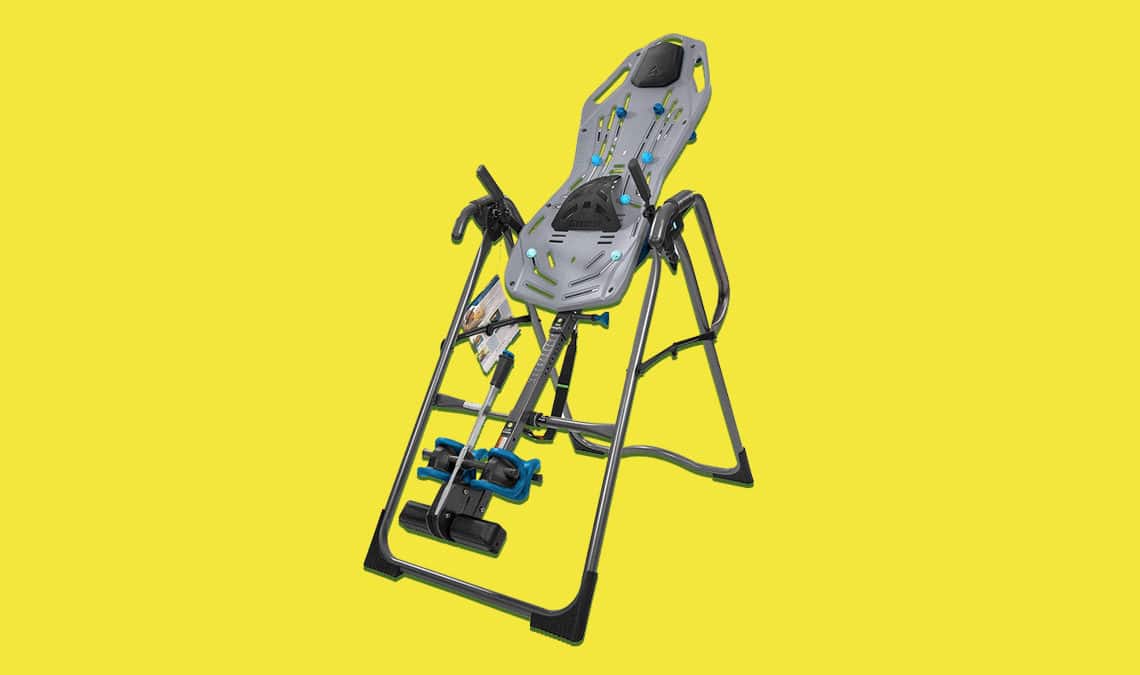
Teeter Reviews: Our Recommendations At A Glance
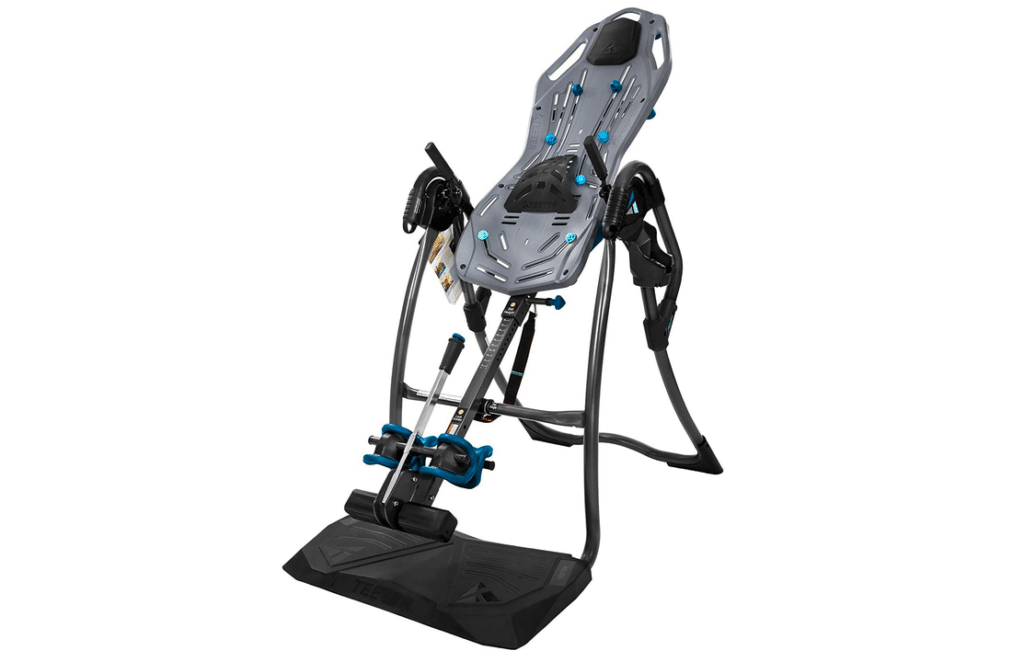
Best Features And Our Recommendation
Teeter Fitspine LX9 Inversion Table
The Teeter Fitspine LX9 has everything you need in an inversion table, plus a bunch of extra features that just make life easier. These include a sleeker, more ergonomic frame for easier entrance and exit, a rubberized platform underneath the frame to help you step into the ankle holders, and a caddy next to one of the handles to hold things like your cell phone, beverage, and a towel.
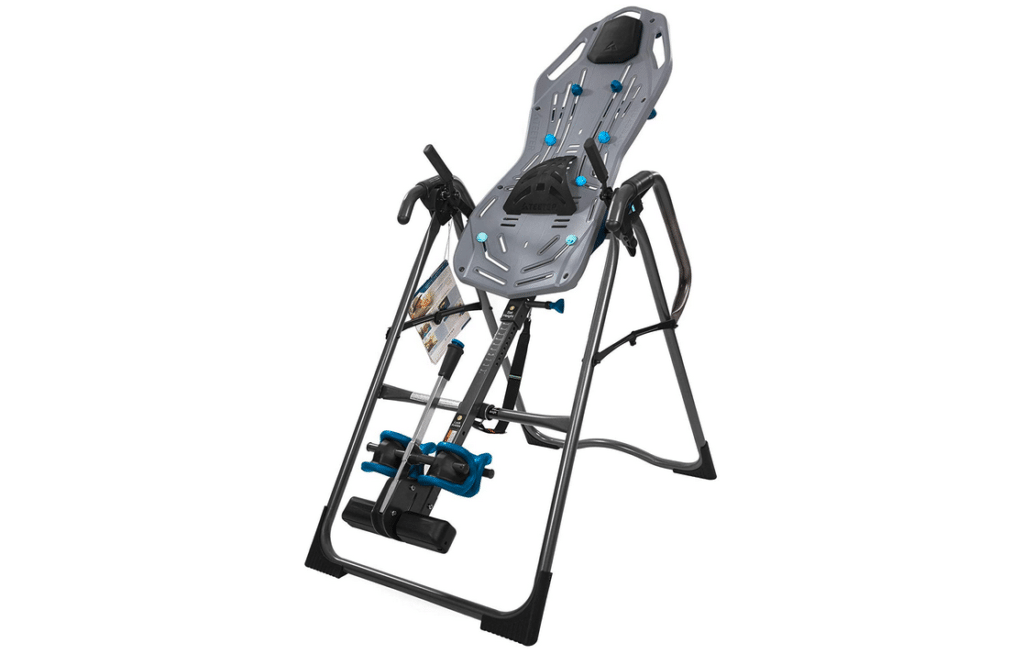
Newer, Mid-Range Teeter Inversion Table
Teeter Fitspine X3 Inversion Table
An improvement over the X2, mainly because of the EZ Stretch traction handles. These allow for a quick release (i.e. reversion to being upright) as well as the ability to push against the handles to manually add traction at lower angles
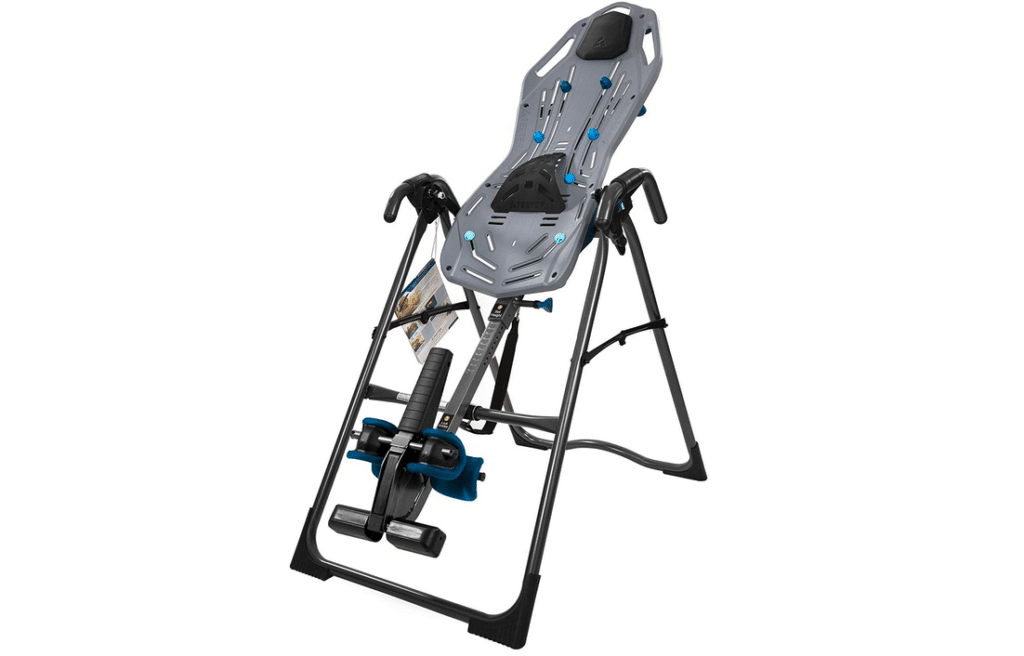
Baseline model with fewest features
Teeter Fitspine X1 Inversion Table
The Teeter Fitspine X1inversion table is Teeter’s baseline model.

Mid-Range, But An Older Model
Teeter Fitspine X2 Inversion Table
The older mid-range model, and includes a few added features for added comfort and ease of use.
For those who don’t know, inversion therapy is a form of spinal traction treatment in which a person hangs upside down by their feet, legs or ankles, stretching and straightening the spine.
Some people use inversion boots to hang completely upside down, but this is uncomfortable for most people, both because of the high pressure put on the feet and ankles, and the feeling of blood rushing to the head. Inversion tables are a more popular solution since they allow people to hang at a variety of angles while proving support to the back, and are also much easier to get in and out of.
Some of the fancier inversion tables add additional features for improving spinal health. Teeter inversion tables are among the more popular brands, for reasons we’ll see shortly.
Best Teeter Inversion Table
Teeter currently has four models of inversion table on offer: the baseline Fitspine X1 model, the mid-range Fitspine X2 which is currently being discontinued, the X3 which is replacing it, and the high-end Fitspine LX9. All share a similar basic design, with higher-end models including more features that add a mix of functionality, comfort and ease of use.
The first thing you’re likely to notice about any of the Teeter Fitspine models is that the table itself– the FlexTech Floating Bed as they call it– is very thin and has a lot of slits cut into it. This makes Teeters lighter than other inversion table brands, and also breathable to minimize heat and sweating during use. But they serve another purpose, as the Fitspine line has several attachments which fit into them.
The Teeter Fitspine X1inversion table, the baseline model, has this basic design as well as two of the features which set Teeter apart from other brands. First, there’s the Fitspine lumbar bridge, a removable attachment which can be placed on the table at the lumbar spine area to support healthy lumbar curvature, adding deeper traction to take pressure off the lower back. It’s particularly helpful for fixing hip misalignment.
Second, the most unique feature of the Fitspine series are the Fitspine acupressure nodes. These are eight little plastic balls which can be slotted into the grooves in the inversion table to exert targeted pressure where the back muscles are sore or tense. They can be moved or removed as needed, as well as adjusted to four different pressure levels.
The Teeter Fitspine X2 inversion table, the older mid-range model, includes a few added features for added comfort and ease of use. These include an improved ankle lock that is both more comfortable while in use, and easier to reach to get in and out of. The handles also feature a more ergonomic design.
The Teeter Fitspine X3 inversion table is an evolutionary improvement over the X2. It features slightly more ergonomic ankle brace and handlebar designs than the X2, but the major improvement is the EZ Stretch traction handles. These allow for a quick release (i.e. reversion to being upright) as well as the ability to push against the handles to manually add traction at lower angles. The grips also make it easy to manually oscillate the inversion table, if you want to.
Finally, the Teeter Fitspine LX9 adds a few more quality of life improvements. These include a sleeker, more ergonomic frame for easier entrance and exit, a rubberized platform underneath the frame to help you step into the ankle holders, and a caddy next to one of the handles to hold things like your cell phone, beverage and a towel.
In short, the Fitspine LX9 is the best Teeter inversion table. It has the most functionality, as well as the greatest comfort and ease of use. The Fitspine X3 however offers all of the same functionality, missing only some of the comfort and usability features.
How To Use Teeter Inversion Table
Teeter inversion tables work largely like any other brand, with the exception of the lumbar bridge and acupressure nodes.
First, you’ll need to adjust the table to match your height. This is crucial for balancing the table properly; get it wrong and you either won’t invert, or will invert too easily and have a hard time getting upright again. You’ll also need to set it for your desired angle of inversion.
Next comes the part that’s unique to Teeter tables. Attach the lumbar bridge if you plan on using it. Then, attach as many acupressure nodes as you want to use, at whatever point you want to apply pressure to, and adjust the pressure levels as desired.
Third, step into the ankle brace and tighten it. It should be tight enough to hold your ankles securely without feeling like your circulation is cut off.
Fourth, invert yourself by extending your arms over your head. This is why it’s important to get the height adjustment right– if the table is perfectly balanced, simply raising your arms over your head will be enough to invert you.
You’ll want to hang for about 10-20 minutes. After that, step five is to get out. Simply extend your arms down (or up, as the case my be) towards your ankles. If this doesn’t do it, you can help yourself up by doing a half-crunch or pulling on the handles. Release the ankle brace, step out and you’re done.
Teeter Inversion Table Weight Limit
Teeter inversion tables have a weight limit of 300 pounds. This is a bit lower than many other brands due to Teeter’s lighter construction.
They also have a height range of 4’8 to 6’6– anyone outside this range can;t be balanced properly.
In practice, a person over 300 pounds probably wouldn’t fit onto the table anyway. They’d either be too tall, or too wide to fit comfortably in between the handles.
Teeter Inversion Table Review: Best Teeter Inversion Table
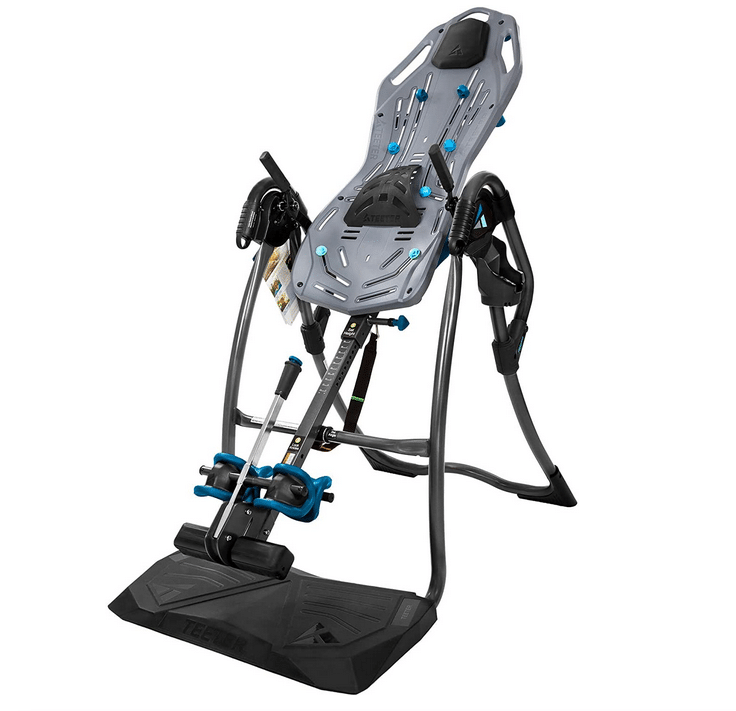
Best Teeter Inversion Table
Teeter Fitspine LX9 Inversion Table
- Flextech Floating Bed
- Ergo-Embrace ankle supports
- FitSpine Lumbar Bridge
- FitSpine Acupressure Nodes
- Deluxe EZ-Reach Ankle System
- EZ-Stretch Traction Handles
- Stretch Max Handles
- LX Ergonomic Frame
- LX Boarding Platform
- LX Storage Caddy
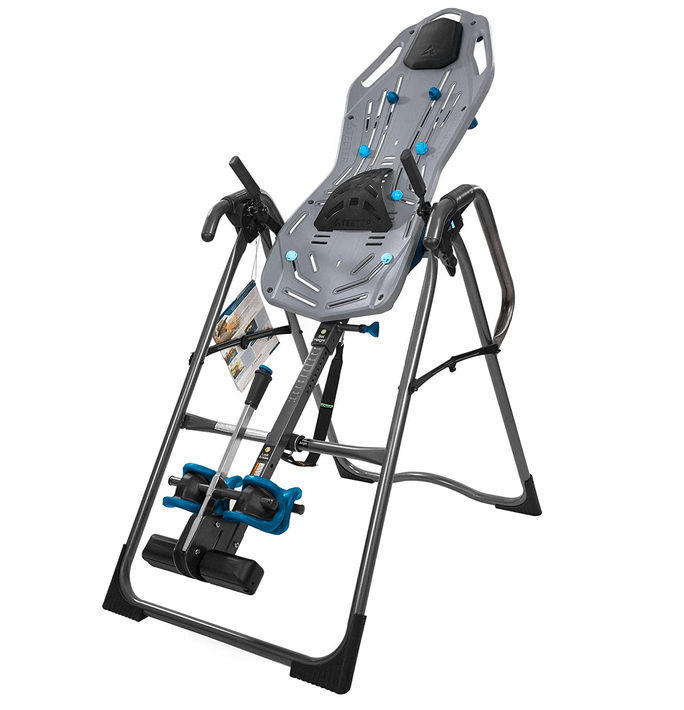
Newer Midrange Teeter Inversion Table
Teeter Fitspine X3 Inversion Table
- Flextech Floating Bed
- Ergo-Embrace ankle supports
- FitSpine Lumbar Bridge
- FitSpine Acupressure Nodes
- Deluxe EZ-Reach Ankle System
- EZ-Stretch Traction Handles
- Stretch Max Handles
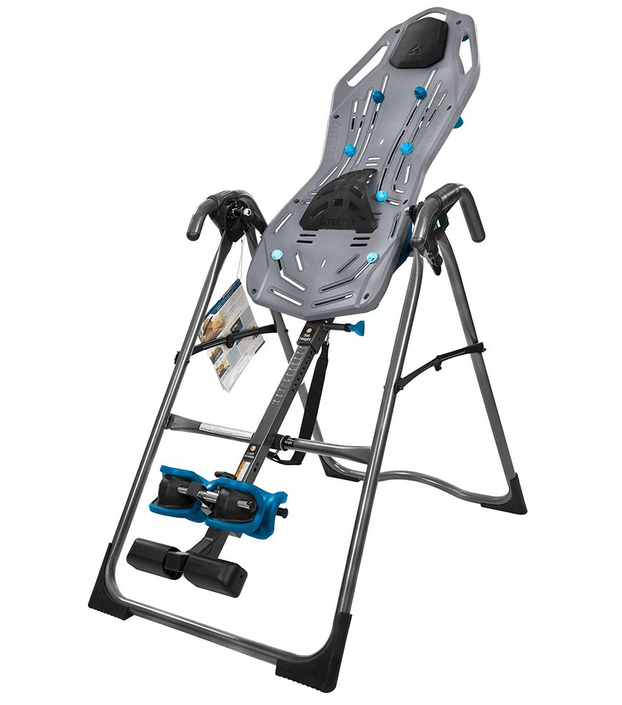
Cheapest Teeter Inversion Table
Teeter Fitspine X1 Inversion Table
- Flextech Floating Bed
- Ergo-Embrace ankle supports
- FitSpine Lumbar Bridge
- FitSpine Acupressure Nodes
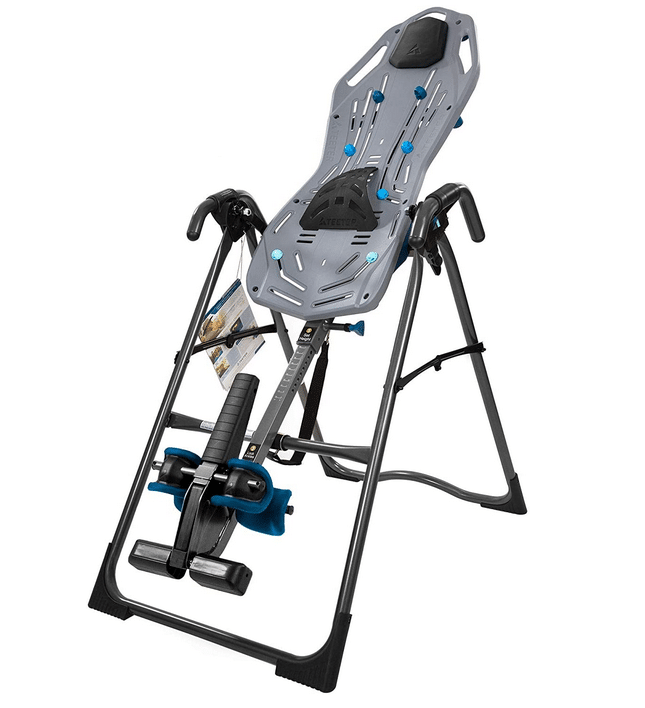
Vintage Midrange Teeter Inversion Table
Teeter Fitspine X2 Inversion Table
- Flextech Floating Bed
- Ergo-Embrace ankle supports
- FitSpine Lumbar Bridge
- FitSpine Acupressure Nodes
- Deluxe EZ-Reach Ankle System
- Stretch Max Handles
Ironman Vs Teeter Inversion Table
Ironman is another brand of high-end inversion table that’s somewhat comparable to Teeter. Its tables feature somewhat heavier construction and a higher weight limit, but the two brands differ mainly in their added functionality.
Whereas Teeter has the lumbar bridge and, more uniquely, the acupressure nodes, Ironman inversion tables have heat pads designed to warm the lower back, loosening muscles and aiding blood flow. This is a good feature, though not one that’s unique to Ironman tables. For more information, you can read our Ironman inversion tables review.
Want to learn more about inversion therapy? Read our article on everything you need to know about inversion tables.
Editor’s note: we are regularly updating this review. If you see any problems, weird interpretations of the data, or just want to say hi, please reach out to hello@the-unwinder.com.
